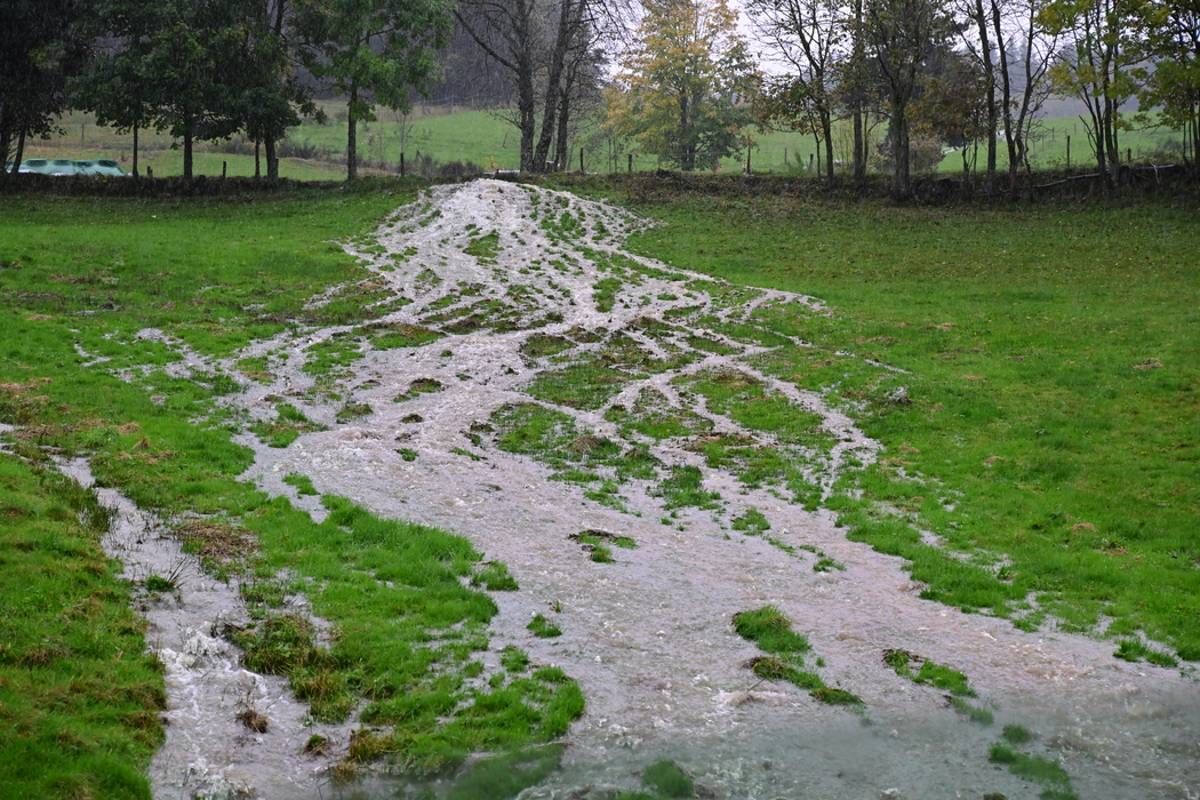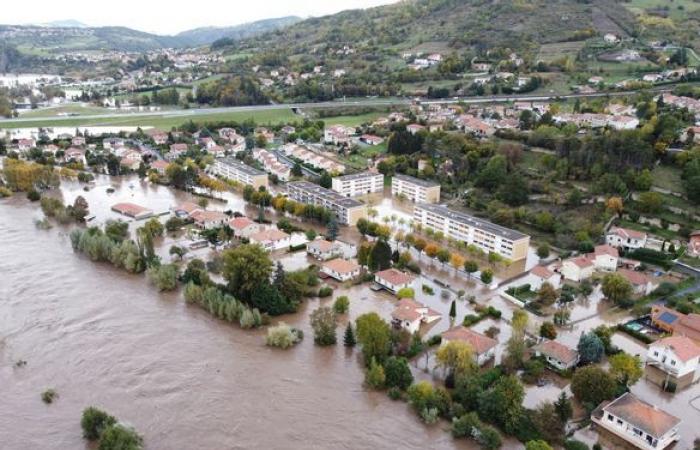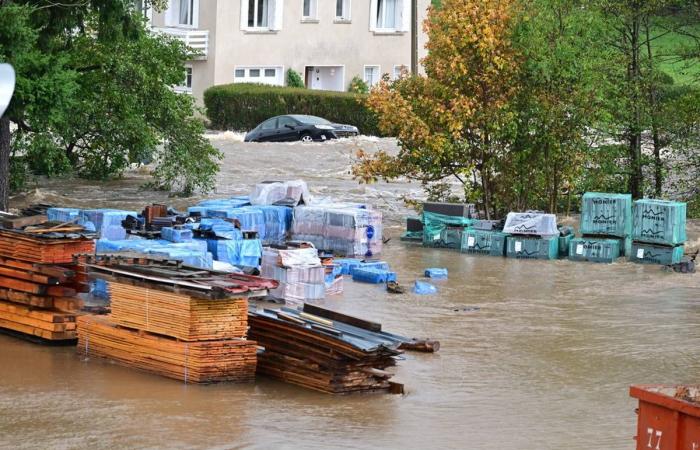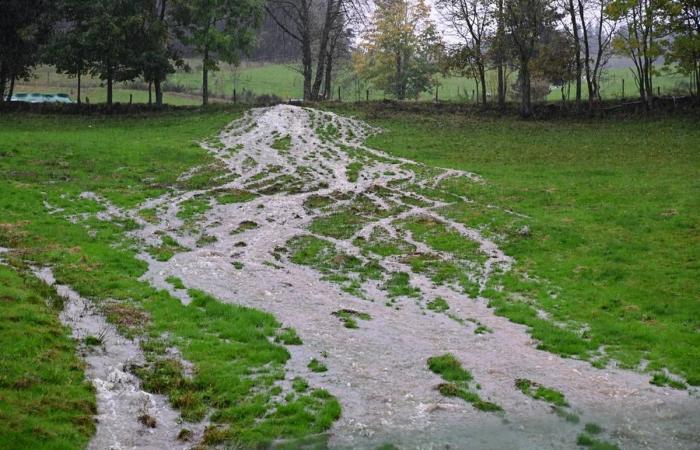The Cévennes episode and the precipitation which affected the Haute-Loire and the Ardèche, and particularly the Mézenc massif as well as the Vivarais Lignon, caused very strong floods on Thursday. The Loire reached its highest level in Goudet since September 1980. In Chadrac, the flood was similar to that of 2008. The Lignon experienced its strongest flooding in 44 years with very heavy damage between Fay-sur-Lignon and Tence.
A dull crack echoes on the road from the bridge to Tence. One of the trees planted in front of the bowling club has just been uprooted, carried away like a wisp of straw by the flood of the Lignon. “It had nevertheless withstood the flood of 1980…”, remembers a resident present on site.
Floods in Haute-Loire: these spectacular images of the Loire in fury
Red alert level activated
This October 17, 2024 will remain a major date in the history of floods in Haute-Loire. The department had been placed on red “flood” alert, which had not happened since November 2, 2008. On the Vigicrues site, only three sections of river were in red in France: all in Haute-Loire. First the Lignon du Velay on Thursday mid-morning, then the Loire Vellave and finally the Haut Allier. Floods caused by the Cévennes episode which affected the entire south-eastern quarter of France and which washed up on the Mézenc massif, causing torrential rains with frightening accumulations in the neighboring Haute-Loire – Ardèche sectors .
Brives-Charensac. Photo Christophe Coffy
The Loire and the Lignon in fury
The flood of the Loire arrived mid-morning in the upstream basin, reaching its peak at Goudet at 10:30 a.m. Thursday, with a level of 7.31 m compared to 5.16 m in 2008. In Chadrac, the Loire was at a maximum of 7.59 m at 1:40 p.m., this time 5 cm below the 2008 level. Visually, in Brives-Charensac, the level was approximately the same as 16 years ago. The flood then descended the valley, arriving at Bas-en-Basset at its peak around 7 p.m., with a level again lower than that of 2008 (4.84 m compared to 5.10 m).A car swept away on the Sérigoule in flood in Tence Thursday morning. Photo Lionel Ciochetto
In Haut Lignon, the damage is very significant (we will return to this in detail in our next edition) in the municipalities of Fay-sur-Lignon, Le Chambon-sur-Lignon and Tence, where many municipal facilities and houses were damaged. affected. Unlike the Loire, the Lignon experienced a flood much higher than that of 2008 and the strongest (probably with a thirty-year frequency) since September 21, 1980.
The Allier at night
If the decline began everywhere on Thursday afternoon, on the Allier river on the other hand, the peak was to take place during the night from Thursday to Friday. “A first flood peak has been reached but a second is expected around 3 a.m.,” state services indicated Thursday evening. We will have to wait until Friday morning to measure the extent of the damage and the level of the flood on the Allier.
A departmental operational center (COD) was activated by the prefecture on Thursday to coordinate relief efforts and prioritize the most affected sectors. Evacuations were carried out on the banks of the Loire and in several dozen houses in Haut Lignon, sometimes with a helicopter as in Brives-Charensac to rescue two people in Audinet. “For the moment, there have been no victims to deplore in Haute-Loire,” indicated prefect Yvan Cordier. The State representative came to the field to take stock of the situation.
On the other hand, several cattle were swept away, such as in Chambon-sur-Lignon and Tence. Their total number remains to be specified. “I saw a cow come to get her calf and they were both swept away,” explained a municipal agent from Chambon, a commune where the technical services were flooded. At least five vehicles were swept away in Tence alone.
Tence, Le Chambon-sur-Lignon, Brives-Charensac, Vorey-sur-Arzon… all the photos and videos of floods in Haute-Loire
In total in Haut Lignon, around fifty homes were affected according to a provisional report Thursday evening. Several companies were flooded, resulting in technical unemployment, such as Mazet-Electronique, which has around thirty employees. Several educational establishments were closed due to flooding, such as the public middle school in Le Chambon and the private high school La Chartreuse in Brives-Charensac. Schools were evacuated and students invited to stay at home, such as in Coubon and Chamalières-sur-Loire.
There will be no regional school transport on Friday in Haute-Loire “except for the repatriation of boarders and emergencies”, announced the Auvergne Rhône-Alpes Region. Traffic on the SNCF Saint-Étienne – Le Puy-en-Velay line has been suspended.
Lionel Ciochetto
In Estables, 269 mm of rain in 24 hours?!
Thursday’s floods are the consequence of a Cévennes episode which strongly affected, from the night of Tuesday to Wednesday, the entire border area between Haute-Loire and Ardèche from the Mézenc massif to Vivarais Lignon, and more far into the Loire up to the Pilat massif. Precipitation which continued again on Thursday morning in a sustained manner in the east of Haute-Loire, with violent thunderstorms and numerous lightning strikes.
These rains were torrential as the records attest. In Estables, where the Lignon has its source (at the foot of the Croix de Peccata), 189 mm fell on Wednesday alone. “This is the 24-hour record for this station which has existed since 2011,” specifies a MétéoNews forecaster. 39 mm had already fallen on Tuesday in Estables, to which was added 134 mm on Thursday between 8 a.m. and 10 p.m. Or around 362 mm in less than three days for the commune of Mézenc, with 269 mm over 24 hours between Wednesday evening and Thursday evening. The waterlogged meadows turned into streams, like here in Chenereilles around 11 a.m. Photo L. Ciochetto
The waterlogged meadows turned into streams, like here in Chenereilles around 11 a.m. Photo L. Ciochetto
In Saint-Jeures, 74 mm were recorded on Thursday in 12 hours to which are added the 75 mm that fell on Wednesday, or 145 mm in a day and a half.
If the Loire is in flood at Brives-Charensac, it is not because of the precipitation that fell at Puy-en-Velay (27 mm on Wednesday at the Puy-Chadrac station and Thursday 6 mm from 8 a.m. until 10 p.m. hours), but far from here, at the head of the watershed, in Ardèche where the river has its source.
To give an idea of the intensity of the Cévennes episode among our Ardèche neighbors, at the Croix de Bauzon (located near the Mediterranean – Atlantic watershed), a total of 549 fell on Thursday around 7 p.m. mm in the space of 24 hours?! In Lachamp-Raphaël, 333 mm on Wednesday and another 54 mm on Thursday at the end of the day, or 430 mm in just 72 hours. Good news: the rain was expected to lessen in intensity during the night from Thursday to Friday. “It will calm down very clearly and the decline will continue everywhere” continues MétéoNews.








